There are many ways to crochet in the round. Each one has its own merits and everyone has their favourite. They are not all interchangeable, but once you understand the ‘anatomy’ behind them, it will be easier for you to decide if you can swap them in specific patterns and how this will affect your work.
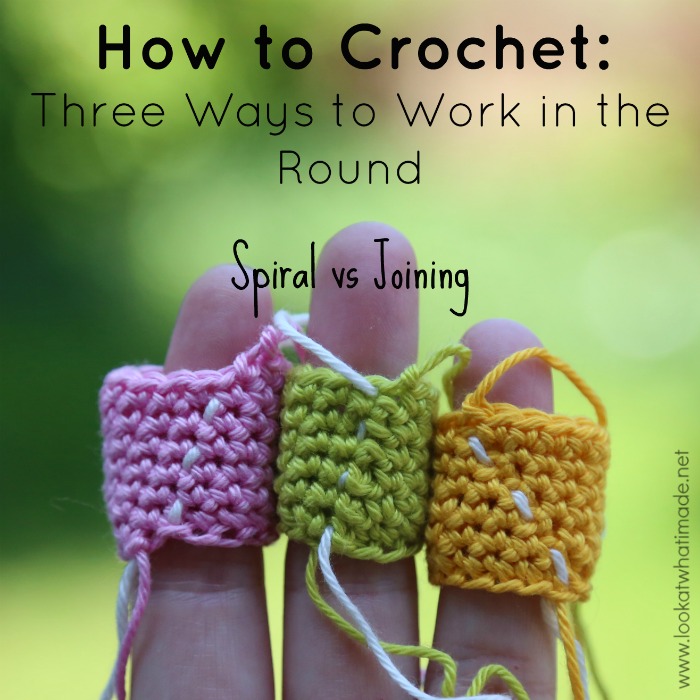
In this post, we will look at:
- Working in a spiral
- Joining in the round: Starting in the same stitch as the sl st join (traditional method)
- Joining in the round: Starting in the stitch after the sl st join (how my Granny taught me)
This photo tutorial will show you how to accomplish each of the three methods listed above. I also hope to shed some light on the differences between the methods. Lastly, I will touch on Interchanging Methods and what would happen if you use one method where another one is required by a pattern.
All three of these methods are worked with the right side always facing you (so no turning at the end of each round).
Note: If you are required to (or choose to) turn at the end of each round, Futuregirl’s seamless single crochet tutorial is an excellent photo-laden tutorial.
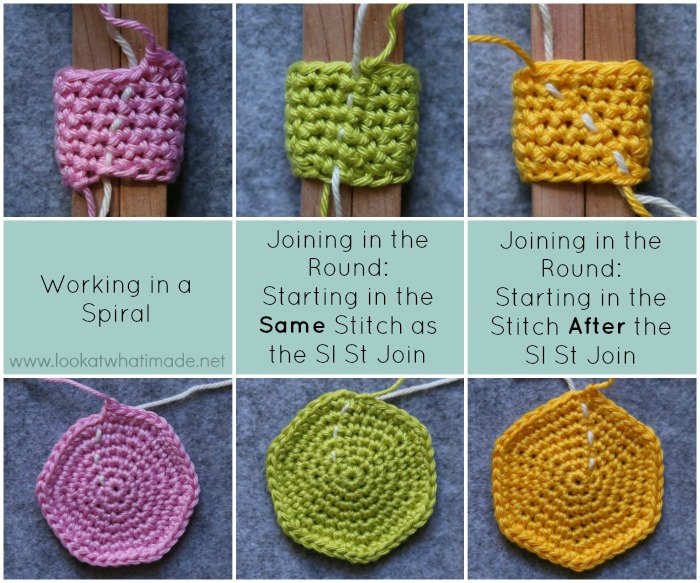
How to Crochet in the Round
A Guide to Working in a Spiral and Joining in the Round
First published 16 June 2013. Updated 8 May 2020.
Notes
- If you do not want to read the whole article, you can skip to the relevant section by clicking on the bullet points below under Index.
- I use US terminology throughout. You can find a US/UK Conversion Chart HERE.
- I have used Running Stitch Markers (RSM) to make it easier to see the seams. I am a massive advocate for them to keep track of the start of each round. A RSM is a piece of scrap yarn that you flick backwards/forwards over your work before making the first stitch of each round. They form a running stitch up your work, making it easy to spot if you have made a mistake in a round. If the line is smooth, you’re good. If the line has a jog in it, you’ve either skipped a stitch or made one too many. When you have finished your piece, you can just pull the scrap yarn out.
- If you struggle with identifying your stitches and which loops belong to which post, you might find it useful to look at this Stitch Anatomy Tutorial.
- For this tutorial, I have started with a 15-ch foundation chain, illustrating the steps by making a small tube in single crochet. Feel free to grab some yarn and follow along with me for a practical lesson.
Index
- Working in a Spiral
- Joining in the Round: Starting in the Same Stitch as the Sl St Join
- Joining in the Round: Starting in the Stitch After the Sl St Join – this is by far my favourite method when not working in a spiral. It yields a very neat seam.
1. Working in a Spiral
This method applies to absolutely anything that needs to be worked in a spiral, regardless of whether it is flat or three-dimensional. What that means is that you won’t join the beginning and end of each round with a slip stitch or an invisible join. Instead, you will continue around, making the first st of each round in the first st of the previous round.
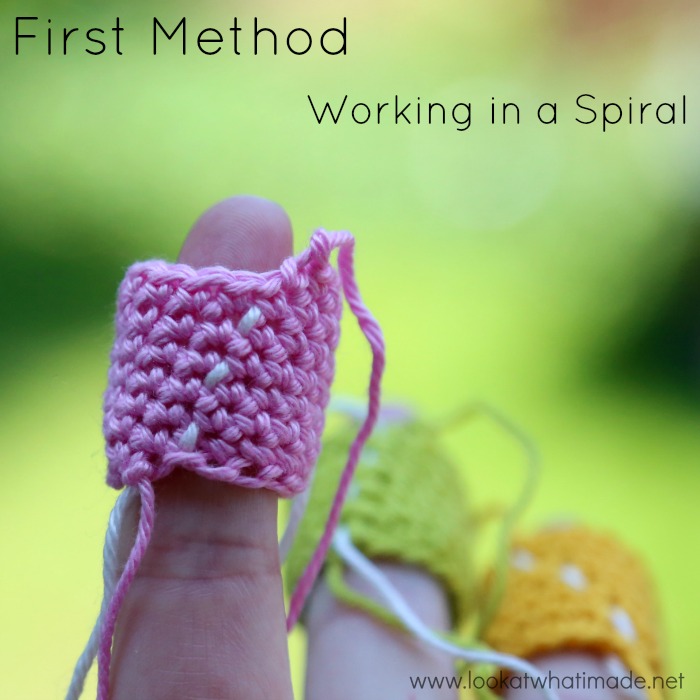
Recommendations
I strongly recommend using a RSM when you work in a spiral as you won’t have any other prompts/cues to remind you where the end of the round should fall. If you are just making a tube, this doesn’t really matter. If you are making something shaped, like a head or a body for Amigurumi, this can be detrimental!
An example of a pattern written for crocheting in a spiral would be:
Ch 15. Don’t turn and don’t join. Just continue around, working the first st of the next round in the first st of this round.
Round 1: Sc in the next 15 sts. {15 sc}
Round 2: Sc in the next 15 sts. {15 sc}
Method
After you have worked your foundation chain {Photo 1}, insert your hook into the first ch (the one farthest away from your hook – indicated by an arrow in Photo 1 and illustrated in Photo 2) and make a sc {Photo 3}.

If you are working in a spiral and you want to use a piece of yarn as a RSM, you can only start doing it from the end of the first round as there is nothing to hold the yarn in place at the end of the foundation chain. Continue to work each st of Round 1 as required by the pattern. Your last st of Round 1 should fall in the last st of the foundation chain {Photo 4}.
Before starting the next round, lay a piece of scrap yarn over your work {Photo 5}. Now crochet the next round, starting in the next available stitch, which will be the first st of Round 1 {Indicated with an arrow in Photo 4}. The last stitch of the round should fall in the st to the right of the scrap yarn (left, if you are left-handed) – see Photo 6.

Continue working your rounds, making the first st of every round in the first st of the previous round and flicking your stitch marker back and forth before the first st of each round {Photos 7 and 9}. If you ARE using a Running Stitch Marker, it will serve as a visual cue that you are still on the right track. The last st of each round should fall in the st to the right of the RSM (left, if you are left-handed) – see Photo 8.

When you work in a spiral you will not have a seam at all. The Running Stitch Marker below shows you where each round started. You can see that it creeps to the right as your crochet item progresses (left, if you are left-handed). If there is a jog in this line, it is an indication that something has gone awry.
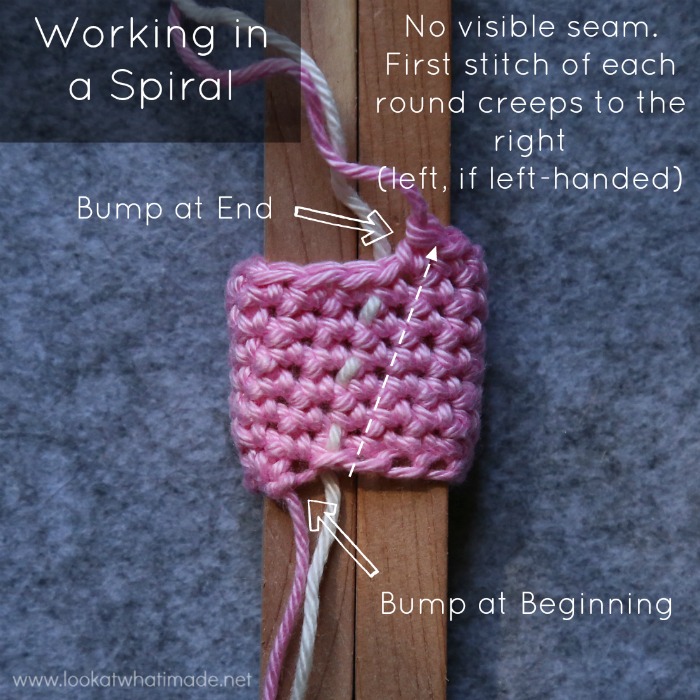
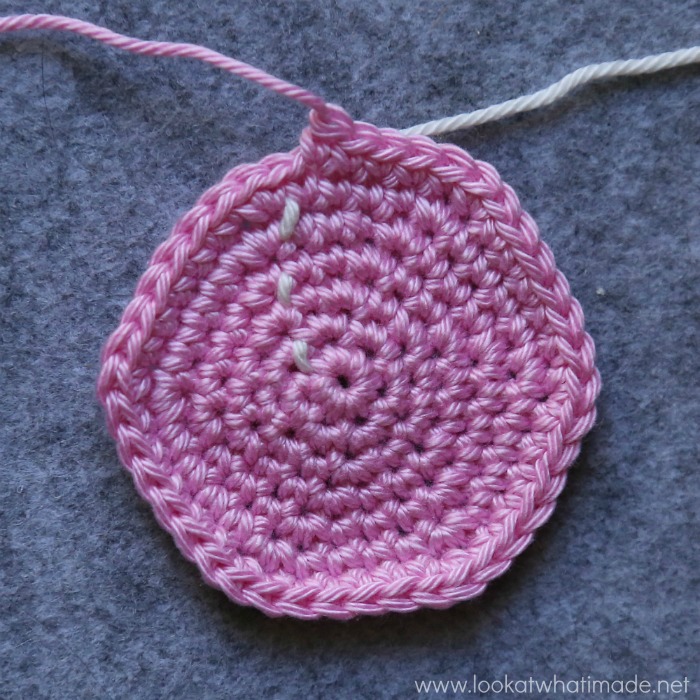
Note
You can apply this method to hdc, dc, and tr stitches. The only difference with using taller stitches in a spiral is that you may want to ‘step’ the first few stitches of the first round. For instance, when starting a dc spiral, I will often replace the first two dc with a sc and a hdc so that the change from the end of Round 1 to the start of Round 2 isn’t as abrupt.
Pros
Working in a spiral is ridiculously easy. No joining and no fussing. As long as you keep an eye on where your rounds need to start and finish, you will be fine!
Cons
The down-side to working in a spiral is that you have a bump at the beginning and the end of your work. This does not make a difference when the piece is sewn onto another piece.
Remedy
I usually just take a yarn needle and thread the initial yarn end through both remaining loops of the last chain stitch. This flattens the bump almost as if you had made a sl st.
To get rid of the bump at the end of your work, most patterns will inform you to sl st in the next st and then fasten off, making the bump less noticeable.
2. Joining in the Round: Starting in the Same Stitch as the Sl St Join
For the most part, this method is completely interchangeable with working in a spiral as the first st of each round creeps to the right in both of these methods. So, if you have a pattern that calls for joining in the round, you can just as easily ignore the sl st join at the end of each round and the ch-1 at the beginning of each round and just continue working in a spiral.

This method applies to absolutely anything that requires you to join in the round, starting each round in the same stitch as the sl st join.
An example of a pattern written for crocheting in the round in this way would be:
Ch 15. Join to the first ch with a sl st to form a ring.
Round 1: Ch 1. Sc in the same st as the sl st join. Sc in each of the next 14 sts. Join to the first sc with a sl st. {15 sc}
Round 2: Ch 1. Sc in the same st as the sl st join. Sc in each of the next 14 sts. Join to the first sc with a sl st. {15 sc}
Method
After you have worked your foundation chain {Photo 1}, insert your hook into the first ch (the one farthest away from your hook – indicated by an arrow in Photo 1 and illustrated in Photo 2) and make a sl st {Photo 3}.

Ch 1 to begin the next round. Each round will start with a ch-1 to get you up to the height you need (if you are using hdc or dc, please see the Note below). This chain stitch does not count as a stitch if you are using sc.
If you are going to use a RSM, lay it over your work after making the ch-1 but before making the first stitch of the round {Photo 4}. Now make the first sc in the same st as the sl st join {Indicated with an arrow in Photo 4 and Illustrated in Photo 5}. Continue working the rest of your stitches. When you get to end of the round, you should have what looks like one stitch left. This is not a stitch, but rather the back-end of the slip stitch join. Skip this stitch AND the initial ch-1 and join to the first st (sc) with a sl st {Photo 7}.
Photo 6 shows the sl st, ch-1, and first sc indicated with arrows.
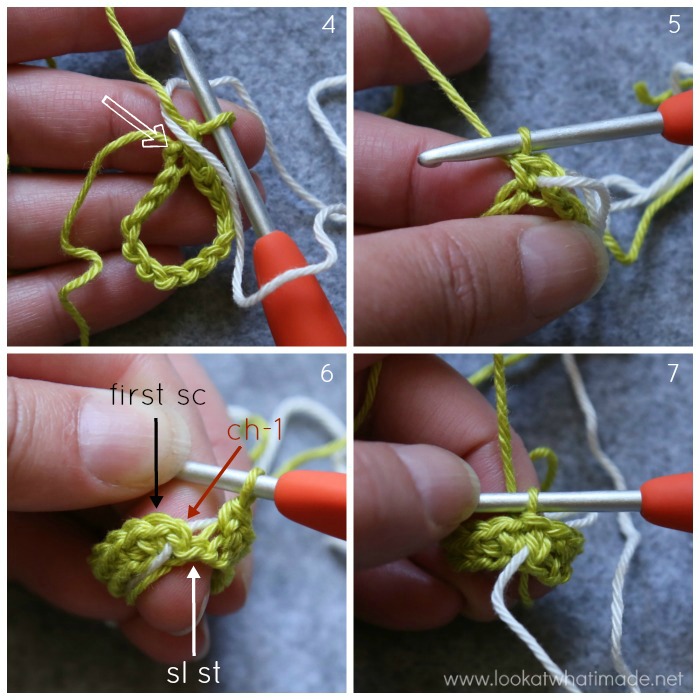
Continue working each subsequent round in the same way, making your first st in the same st as the sl st join and skipping the sl st join and the initial ch-1 when joining at the end of the round.
Remember to flick your Running Stitch Marker backwards and forwards after each initial ch-1, taking care to note that the RSM will hide the stitch you need to work into. Pull it to the side so that you can see your stitches properly.
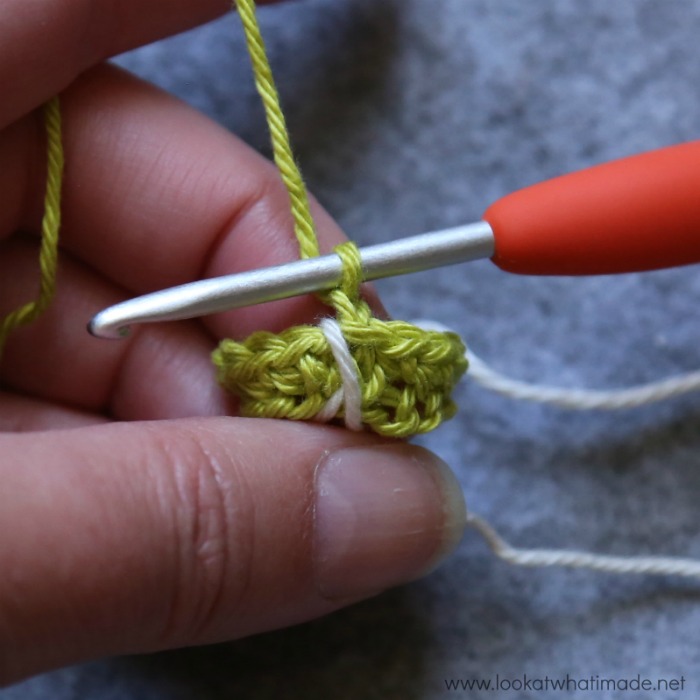
When you join in the round like this, you will get quite a visible seam that will creep slightly to the right as your item progresses. Because you are skipping the join and the initial ch-1, your seam will be gappy, with visible bumps created by the skipped sl sts.
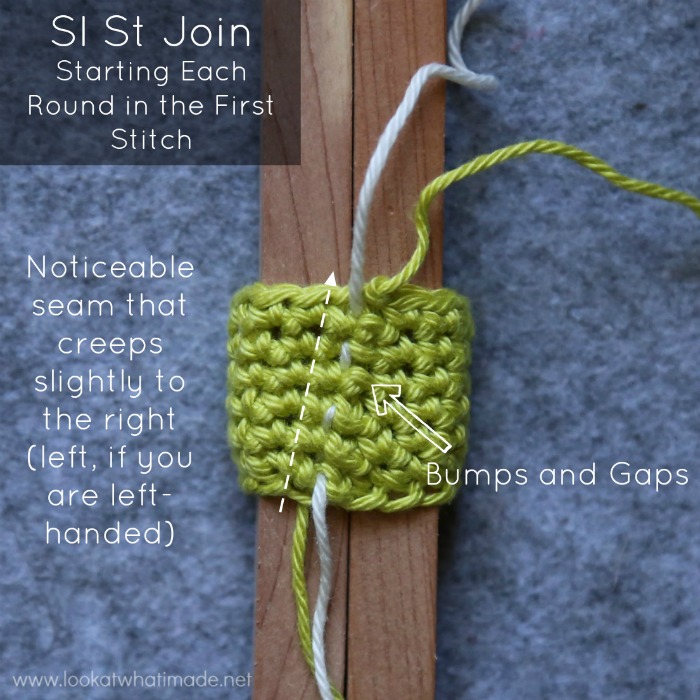
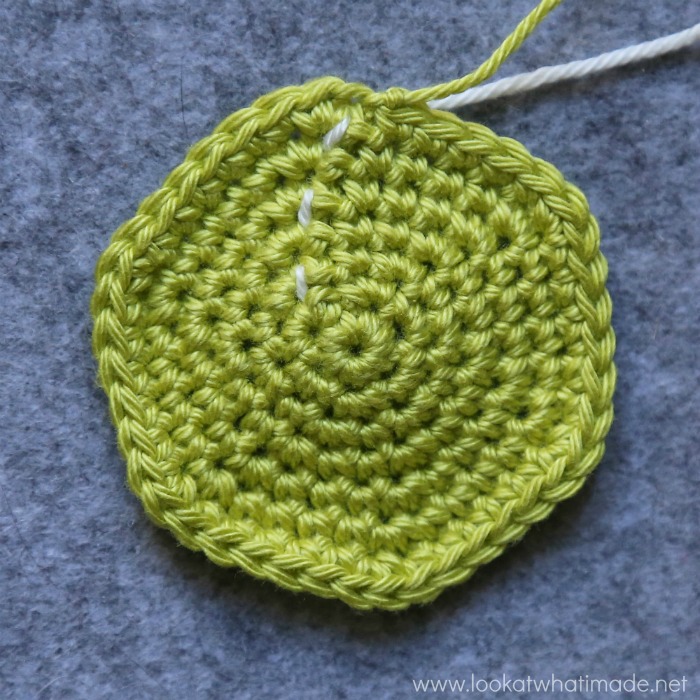
Note
If you are using hdc or dc, you will have to consult the relevant pattern. Sometimes the starting chain doesn’t count as a st, in which case you will ignore it when joining the round. If it DOES count as a st, you will join to it when you get to the end of the round, treating it as a hdc or dc – as indicated in the relevant pattern.
My personal preference is to make my starting chain one ch shorter than it would usually be and have it not count as a stitch. For example, if I am making a dc rug, I would start with a ch-2 (usually ch-3 for dc height) and then make my first st in the same st as the ch-2. When I get to the end of the round, I would skip the sl st and the ch-2, and join to the first dc with a sl st.
Pros
Joining in the round like this makes it easy to keep track of your stitch counts. At the end of each round, you should have a st left before the st marker (this will be the joining sl st). If you don’t have a st left, or you have 2 sts left, it immediately flags up the fact that you have made an error, either in this round or in the previous one.
The start and end of the work will also be neater than when working in a spiral.
Cons
The seam is clearly visible and can be an eyesore, especially if you change colours at the end of each round.
Remedy
If you are only making a tube or something where the placement of your increases is not particularly important, you can consider using futuregirl’s method for seamless single crochet. This method involves turning the work at the end of every round though, so is only suitable for things where the placement of the increases is not important! You cannot turn your work on things like a shaped Amigurumi head unless the pattern specifically calls for the work to be turned.
If you are changing colours at the end of each round, you might want to use an Invisible Join instead of a Sl st Join. I LOVE the Invisible Join and use it wherever possible.
3. Joining in the Round: Starting in the Stitch After the Sl St Join
This is the method my granny taught me and I prefer it for various reasons. It is NOT interchangeable with the other two methods AT ALL, unless you are only working a tube or a flat circle where the placement of the increases doesn’t matter.
I use this method for my Amamani (Amigurumi Amish Puzzle Animals), specifically the rhinosaur, the elephant, the dinosaur, the horse and the giraffe.
Update 2020: For the Amamani book, I rewrote the patterns for all but the Rhinosaur and the Horse to use a spiral join instead.
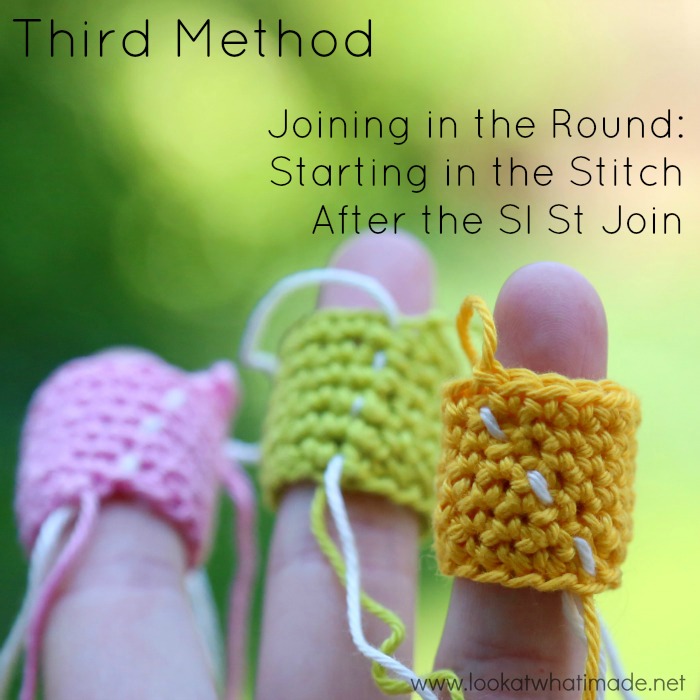 This method applies to patterns where the designer specifically expresses that the first stitch should not be worked in the same st as the sl st join. You won’t find many of those!
This method applies to patterns where the designer specifically expresses that the first stitch should not be worked in the same st as the sl st join. You won’t find many of those!
An example of a pattern written for this method would be:
Please note: for the purposes of this pattern, do not make your first st in the same st as the sl st join. This will mean that your last st will fall in the back end of the sl st join, which is quite tight.
Ch 15. Join to the first ch with a sl st to form a ring.
Round 1: Ch 1. Sc in the next 15 sts. Join to the first sc with a sl st. Remember that you should not make your first st in the same st as the sl st join and that your last st will fall in the back end of the sl st join. {15 sc}
Round 2: Ch 1. Sc in the next 15 sts. Join to the first sc with a sl st. {15 sc}
Method
After you have worked your foundation chain {Photo 1}, insert your hook into the first ch (the one farthest away from your hook – indicated by an arrow in Photo 1 and illustrated in Photo 2) and make a sl st {Photo 3}.

Ch 1 to begin the next round. Each round will start with a ch-1 to get you up to the height you need (if you are using hdc or dc, please see the Note below). This chain stitch does not count as a stitch if you are using sc.
If you are going to use a Running Stitch Marker, lay it over your work after making the ch-1 but before making the first stitch of the round {Photo 5}. Now make the first sc in the st AFTER the sl st join, so the first open st {Indicated with an arrow in Photo 4 and Illustrated in Photo 6}. Continue working the rest of your stitches. The last st of the round should be quite tight to get into as it is the back end of the sl st join.
Photo 7 shows the last st that you will need to work into (white arrow) as well as the initial ch-1 (red arrow) and the first sc (black arrow).
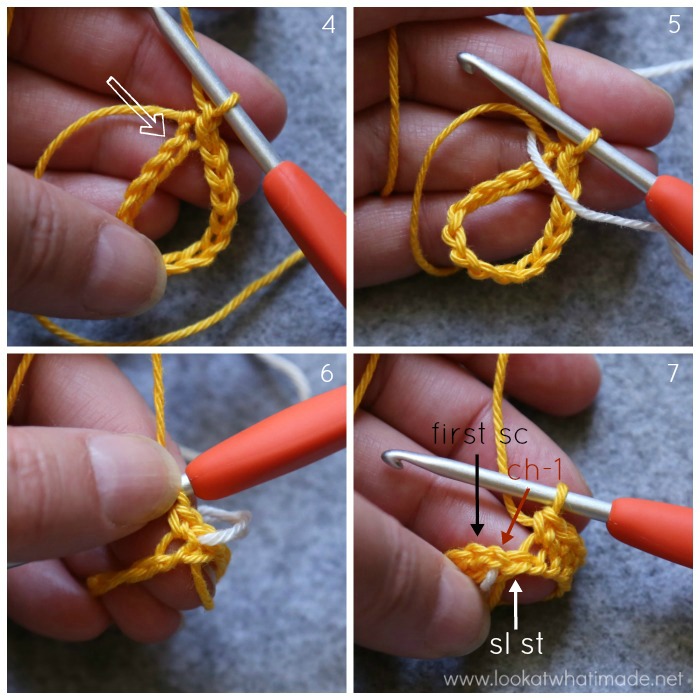
Photo 8 shows the last st of the round made into the back end of the sl st join. This will bring you to the initial ch-1 of the round, which will fall directly over the running stitch marker {Photo 8}. Skip this initial ch-1 and join to the first st (sc) with a sl st {Indicated with a black arrow in Photo 8 and Illustrated in Photo 9}.
If you are using a Running Stitch Marker, remember to flick it backwards and forwards at the beginning of each round {Photo 10}.

When you join in the round like this, you will end up with a seam that creeps significantly to the LEFT (right, if left-handed).
BUT
The resulting seam will be a lot neater than if you had started in the same st as the sl st join.
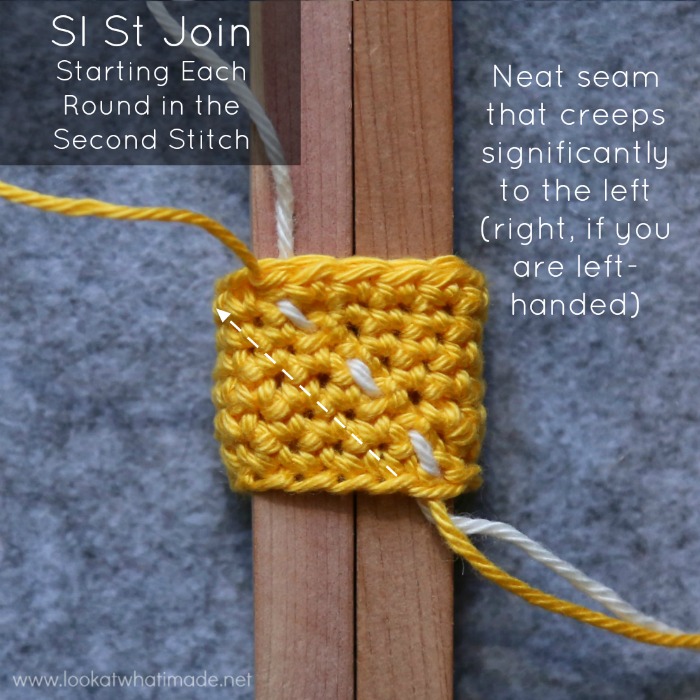

Note
If you are using hdc or dc, you will have to consult the relevant pattern. Sometimes the starting chain doesn’t count as a st, in which case you will ignore it when joining the round. If it DOES count as a st, you will join to it when you get to the end of the round, treating it as a hdc or dc – as indicated in the relevant pattern.
My personal preference is to make my starting chain one ch shorter than it would usually be and have it not count as a stitch. For example, if I am making a dc rug, I would start with a ch-2 (usually ch-3 for dc height) and then make my first st in the same st after the ch-2. When I get to the end of the round, I would skip the ch-2, and join to the first dc with a sl st.
Pros
Joining in the round like this is NEAT! The resulting seam is visible but smooth and not ugly.
The tightness of the last st you work into (the back end of the sl st join) acts as an extra prompt that you have indeed worked all your stitches correctly.
If the last stitch I work into is not tight, it prompts me to check all the stitches in my round. It can be indicative of a mistake in the current round or the previous one.
Cons
This method is not interchangeable with the other two methods (unless you are purely working a tube or a flat circle). Because the first stitch of every round creeps to the left in this method and to the right in the others, it will cause massive problems if you are working a shaped object like an Amigurumi head.
If a pattern is written to be worked in a spiral or calls for the first stitch to be made in the same stitch as the sl st join, using this method instead will place the increases in a completely different spot. This won’t be so noticeable on the first round, but the more rounds you have, the more your increases will be offset from where they should be.
It can get ugly very fast!
Remedy
None, unfortunately. Use this method only if a pattern calls for it specifically! Or be prepared to do a lot of maths to re-write the pattern.
Interchanging Methods
As I have already mentioned, the Spiral Technique and the First Technique for joining in the round (making your first st in the same st as the sl st join) are completely interchangeable as the first st of each round for both of these creeps steadily to the right at more or less same angle.
If you want a completely straight seam, futuregirl’s seamless single crochet tutorial offers you the best choice, but you will have to turn at the end of each round. This means that you cannot interchange this method with any of the three I mentioned UNLESS you are only working a tube (like an octopus tentacle) or a flat circle (like a coaster or a Round Rag Rug) where the position of the increases doesn’t matter as much.
My favourite by far is the Second Method for joining in the round where you make your first st in the st after the sl st join. But this method, like future girl’s method, is not interchangeable with any of the other methods if there is any shaping involved. Like I have already said, the seam for this method creeps significantly to the left. So if you used this method where any of the other methods were called for, you’ll end up with a very lopsided item. You can, however, use it in patterns where there are no increases or the placement of the increases doesn’t matter as much.
Phew! What a mouth full.
I hope you have found this tutorial helpful and would love to hear from you if you have (or even if you haven’t). Do you have a different approach to joining in the round? Or maybe you have a hint that makes working in the round easier.

This blog post contains affiliate links. I only link to products I personally use or would use. All opinions are my own.



Carmen says
The beginning chain and sl st at the end had me so confused… I think I got it now. So if the stitch count is 12 at the end of the round, there will actually be 13 because the slip stitch doesn’t get counted, correct?
Beth Arduini says
Oh my goodness, using a piece of thread to mark my work as I go was a game changer. I’ve been struggling working in the round and your tip about putting the thread under the chain stitch really changed things up and I managed to make a little bowl and it’s perfectly round.
Jenny Lowman says
Yay! Glad you found it helpful!
Mary K Mattheus says
Thank you so much! I have always been confounded by crooked lines in my circular joins!
Susan says
You did a fantastic job detailing the three methods and I found this extremely helpful. I had noticed more patterns using the spiral method and prefer that to the the slip stitch join (which is why I was looking for an explanation of the stitch details) but I haven’t seen the third method you explained before today. I’ll have to give that a try!
Jenny Lowman says
We hope you enjoy it, Susan :)
Amaris I. says
This is so incredibly helpful! I’m working on a project right now that requires a different type of joining and I was SO confused! (I’ve only ever crocheted in a spiral for my basic projects) I couldn’t really find video tutorials that walked the process all the way through. Thankful I happened upon your blog when searching as I believe the 2nd method is the one this pattern calls for and I’m relatively new to crocheting so I REALLY APPRECIATE all the photos you have and how descriptive you are in explaining this. Thank you thank you thank you! I think going forward, this pattern will be A LOT easier to follow. ^_^
Jenny Lowman says
Glad you found Dedri’s tutorial so helpful! Enjoy :)
Theresa Cano says
Thank you so much for this explanation! I have a pattern that uses method #3 but I didn’t realize that and I thought I’d completely forgotten how to math. You just saved me from a ginormous headache!
Dedri Uys says
I am so pleased to hear that you found it useful!